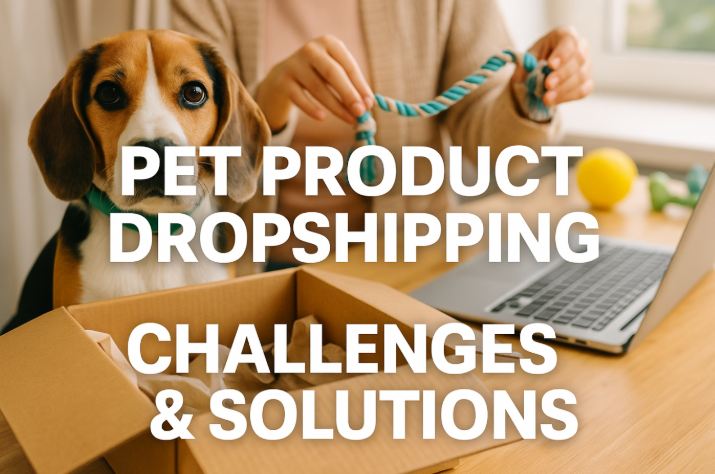Introduction
Over the last ten years, the pet sector has undergone a massive shift. Once a niche, it now ranks among the most profitable areas of global e‑commerce. Pets are increasingly viewed as family members, often called “fur babies,” and this bond drives huge demand for premium items such as gourmet food, cozy beds, smart collars, and interactive toys. Research indicates that U.S. pet owners alone pour over $100 billion each year into their companions, and the figure keeps rising.
For business owners, this swelling demand signals a profitable opening. One popular entry point is pet‑product dropshipping, which removes the need for large upfront inventory or storage costs, letting sellers showcase a broad catalog without ever handling the merchandise. In theory, it’s the ideal blend of low risk and high payoff.
Yet the reality is messier. While dropshipping is convenient, it brings hurdles that brick‑and‑mortar retailers don’t encounter. You’re up against a sea of other online pet shops, rely on third‑party suppliers for product quality and shipping, and must earn the confidence of customers who are fiercely protective of their animals. These obstacles can be daunting and are often why many dropshipping ventures fizzle out before gaining momentum.
Another reason pet product dropshipping is attracting interest is the sector’s durability. Unlike many markets that swing with trends or seasonal demand, the pet industry stays steady even during tough economic periods. Pet owners seldom cut back on basics like food, health supplies, or grooming tools, and many still indulge in non‑essentials such as toys and accessories. This consistency makes the field a dependable choice for entrepreneurs seeking long‑term ecommerce opportunities.
However, consistency doesn’t equal ease. Running a pet dropshipping store successfully involves far more than listing items and hoping for sales. It calls for careful planning, effective marketing, and a solid grasp of what pet owners truly value. Sellers must balance cost, quality, and credibility, a balance that can be hard to achieve without a clear strategy. Recognizing these challenges from the start is the first step toward creating a shop that stands out in a crowded marketplace.
The good news? Each of those roadblocks can be managed with a solid plan. Entrepreneurs who study the pet dropshipping landscape, cultivate reliable supplier ties, and differentiate their brand can not only stay afloat but flourish. This piece outlines the key challenges you’ll face when dropshipping pet goods and, more importantly, how to convert those challenges into growth opportunities.
Standing Out in a Competitive Market: Dropshipping Pet Products
Competition is the first barrier most newcomers encounter. With thousands of sellers entering the e-commerce arena each year, the pet niche is especially saturated. Search for “pet toy” or “dog bed” online, and you’ll see endless stores offering almost identical products. If your business looks like everyone else’s, shoppers have no reason to pick you.
The answer isn’t to carry everything, it’s to sell wisely. Instead of being a generalist, thriving stores focus on specific niches. Consider the problems or wishes of distinct groups of pet owners. For instance:
- Eco‑aware buyers seek biodegradable poop bags, bamboo bowls, and organic treats.
- Senior pet owners need orthopedic dog beds or joint‑support supplements.
- Cat lovers look for interactive toys that curb boredom.
- Upscale pet parents may splurge on luxury leashes or custom accessories.
By narrowing your scope, you speak directly to a smaller, more devoted audience. You’re not merely offering products, you’re delivering solutions that match a customer’s lifestyle and values.
Branding matters just as much. A plain online pet shop that relies on generic photos and vague copy seldom gains credibility. In contrast, a brand that showcases a distinct personality approachable, reliable, and perhaps even whimsical feels authentic and human. Sprinkle storytelling throughout your product listings, display pets actually using the items, and craft content that positions your shop as more than a simple storefront.
When you pair niche positioning with great branding, you stop competing solely on price. You compete on value and identity, and that’s what makes you stand out in the crowded pet‑product dropshipping space.
Quality Control and Supplier Dependability
A major danger in dropshipping is entrusting your reputation to suppliers you can’t fully oversee. If they slip up, you suffer the consequences. In the pet product niche, this threat is even greater because shoppers are purchasing items for their cherished companions. A cheap toy that falls apart after a single use, or an unsafe, poorly crafted product, can damage more than just your finances, it can tarnish your credibility.
Typical supplier‑related problems include:
- Inventory shortages: An item you’ve been advertising unexpectedly runs out of stock.
- Shipping delays: Deliveries arrive weeks later than promised.
- Subpar packaging: Products reach customers damaged or in unappealing packaging.
- Variable quality: The sample you approved looks perfect, but the items customers receive don’t meet that standard.
Testing products before listing them, building proper conversations with providers, and providing backup options in place are important. Pet owners count on merchandise which can be safe and durable, so prioritizing supplier reliability directly builds long-term trust.
To reduce these risks, you need to vet providers carefully. Don’t depend entirely on online reviews or catalogs. Order samples, test the first-class yourself, and compare it to customer expectations. If you wouldn’t give the product to your very own pet, it doesn’t belong in your store.
Building strong conversations with suppliers is similarly important. A dependable companion is responsive, transparent, and proactive whilst troubles arise. Some dropshippers even paint multiple providers for the same product, making sure they have got a backup plan if one fails.
In this business, your provider isn’t only a supplier, they’re an extension of your brand. Choosing wisely and keeping relationships will pay off in fewer troubles and happier clients.
The Obstacles of Shipping and Delivery Times
Online shoppers have grown used to fast delivery. Services such as Amazon Prime have raised expectations so high that a two‑to‑three‑week wait feels almost intolerable. For people with pets, the irritation spikes. Picture ordering a new chew toy for your dog, only to endure three weeks while your pup gnaws your slippers.
This timing issue sits at the heart of dropshipping pet goods, particularly when the supplier is abroad. Lengthy shipping windows can trigger poor reviews, order cancellations, and lost repeat business.
How do the top dropshippers overcome it?
- Partner with nearby or regional vendors – many now keep stock in U.S., European, or other key locations, cutting transit times dramatically.
- Be upfront about shipping times – customers tolerate delays when they’re told the real estimate from the start; honesty builds credibility.
- Blend product offerings – keep a selection of fast‑shipping staples on hand while still listing niche items that naturally require longer lead times.
- Supply tracking information – letting buyers follow their parcel makes them feel more in control and reduces anxiety.
Some entrepreneurs even spin longer delivery into a selling point. If you’re offering handcrafted or specialty items, labeling them “made to order” or “carefully imported” can turn a perceived inconvenience into a sense of exclusivity.
In the end, the objective isn’t merely lightning‑quick shipping; it’s setting clear expectations and keeping shoppers informed throughout the process.
Winning Customer Trust in the Pet Market
Trust is the cornerstone of this industry. Pet owners are naturally protective and rightly so, because they want dependable, safe products for their companions. A single bad experience can drive them away for good.
To win and retain that trust, your online pet shop must be more than just a product list. It needs character, credibility, and evidence. Here’s how to create it:
- Professional branding: A sleek, well‑designed site conveys reliability. Steer clear of anything that feels hurried or amateurish.
- Social proof: Showcase customer testimonials, photos, and reviews. Seeing real animals enjoying your items reassures prospective buyers.
- Clear policies: A straightforward return and refund policy signals confidence in what you sell.
- Educational content: Blog articles, guides, or videos on pet care position your brand as a helpful resource, not merely a transaction platform.
A highly effective tactic is user‑generated content. Prompt customers to post pictures of their pets using your products on social media. This not only provides free promotion but also cultivates a community vibe around your brand.
Trust isn’t built overnight. It develops over time through consistent quality, honest communication, and genuine interaction. In the pet market, where emotions run deep, trust is your most valuable asset.
Beyond the Basics: Marketing Challenges in Pet Dropshipping
Even after you’ve secured suppliers and sorted shipping, there’s still one major obstacle: marketing. A lot of fresh dropshippers overlook how tough it can be to draw customers in initially.
Paid campaigns on sites like Facebook, Instagram, or Google can quickly become pricey, especially when you’re bidding on hot‑term keywords such as “pet supplies” or “dog toys.” Organic growth via SEO is a slow‑burning process that demands patience. And because pet owners are bombarded with ads every day, cutting through the clutter calls for a dash of creativity.
Here are a few tactics that can set you apart:
- Content marketing: Publish helpful pieces on pet care, training advice, or product round‑ups. This drives SEO traffic and positions your store as a go‑to resource.
- Influencer collaborations: Team up with pet influencers. Whether a well‑known Instagram pup or a local trainer to add credibility and reach an engaged audience.
- Email outreach: Grow a list of previous buyers so you can promote new items and deals without relying exclusively on paid ads.
- Story‑driven ads: Instead of merely showcasing products, build ads around feelings. For example, illustrate how a particular toy eases a dog’s anxiety when its owner is away.
Marketing isn’t just about pushing sales, it’s about forging a connection. Pet owners want to feel that you truly get their affection for their animals. If you can tap into that sentiment, your shop transforms from a simple retailer into a trusted brand.
Conclusion
Launching a pet‑product dropshipping business might look easy at first glance. Yet it’s riddled with hidden pitfalls. Intense competition, supplier dependability, lengthy delivery windows, and the task of earning customer trust are only the beginning. Add marketing obstacles to the mix. It becomes clear that success isn’t a roll of the dice. It’s a product of deliberate strategy.
Looking forward, the pet sector shows no hint of a slowdown. Indeed, it is evolving quickly, with trends such as smart pet gadgets, subscription boxes, and eco‑friendly products gaining momentum. Dropshippers who adapt early, heed their audience, and keep investing in brand trust will be well‑placed to thrive in this vibrant future.
Keep in mind: in the pet sector, success isn’t judged solely by profits, but also by wagging tails, contented purrs, and the loyal clientele your brand cultivates. Each item you ship holds the ability to enhance a pet’s well‑being and deepen the connection between animals and their people. That sense of purpose is what makes this trade so fulfilling.
For entrepreneurs ready to tackle the obstacles head‑on, pet‑product dropshipping is more than a mere business framework; it’s an opportunity to create something significant, enduring, and intimately woven into everyday life. When a love for pets aligns with savvy strategy, the possibilities are boundless.









